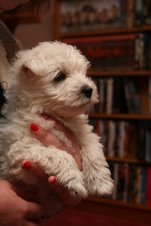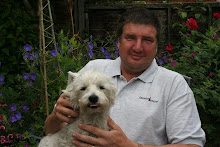 |
Not the best picture but you may be able to make out green
pollen baskets on 2 of these returning workers. |
Part of the pleasure of beekeeping to me is the simple act of relaxing and watching the bees come to and from about their foraging work and we are always reassured when we see the pollen baskets on their legs laden with pollen. Pollen is high protein food (well, an ingredient anyway) for young growing larvae, so when you see pollen being brought in you are reassured that Her Majesty is inside and laying well. I was taken by surprise this week when I spotted that some of this pollen (which I knew could come in all colours depending on flowers foraged) was a bright orange-red and other bees were bringing in pollen of a very bright green. Neither of these colours had I seen before.
 |
Favourite flower with the bees this week is our huge and spreading
blue geranium "Orion". |
A quick flurry of research on the net and a few questions to beekeeper contacts on Facebook revealed that other Irish beekeepers were also getting the red and the bright green. It also pointed me at some websites where colour charts have been set up for you to match your pollen with and marry that to your known list of plants currently in flower within the likely forage radius (about 2.5 km) of your bees. The green, which is described as 'very bright' by most beekeepers and "almost day-glo green" by one is thought to be coming from Meadowsweet (
Filipendula ulmaria). That works for me - we have loads of it here; it follows from Queen Anne's Lace (Cow Parsley;
Anthriscus sylvestris) and the Ground Elder (
Aegopodium podagraria) in all the verges and hedgerows.
 |
Saving the goose pinion feathers - my fellow
members of the Longford Beekeepers use them
as 'bee brushes' in their hive work. |
The bright red is more of a problem. It is thought to be from either Field Scabious (
Knautia arvensis) or the 'Henbit' dead nettle (
Lamium amplexicaule). I have seen some of the scabious down on the bogs when I am out dogwalking but so far not with bees on the flowers, but the dead nettle, if it is round here in quantities big enough to get the bees interested, has eluded me so far. Never mind - it is all fascinating detective work and good to know what is going on with the bees in my local area. I have seen plenty of purple pollen being collected, of course, but that is from the deliberately planted stand(s) of
Phacelia tanacetifolia just yards from the hive; you can see individual workers nip out from the hive, buzz around the flowers (it takes them half an hour at least to load up, so I don't follow the same bee around, but you get the picture) and then nip home to unload.
 |
| Out in the big wide world, the "Gang of Four" |
We have had a nice warm week, all be it interupted occasionally by showers, so we have been progressing the 'rearing' of our various baby birds. The first hatch turkeys are now big enough, and the young Guinea Fowl settled enough for us to be confident letting them out of the rabbit run to go fully free range without the young cat Soldier, who scared us a bit when we tried this a week or so back, hunting them.
 |
Not a bad job, sitting in the sun supervising the first exploratory
ramblings of the 'Gang of Four' |
We do this on a warm dry day when we are all caught up with jobs and can afford to sit for an hour or two watching the birds take their first tentative steps out into the wider world. In this case, too, some first try-outs of the wings - these guys seemed delighted that you could actually take off and do little practise flights up to about 3-4 feet, not anything they could really do in a rabbit run only 45 cm high. They were perfectly behaved in the event.
 |
| I'll sit this one out, then. Goldie's daughter Nugget chilling. |
The 2 guineas and 2 turkeys have settled in as a solid tight-knit group, whom we call the 'Gang of Four' and they stay together when exploring and meeting any other of our birds. We did wonder whether the guineas might naturally gravitate towards love-lorn widow-bird 'Min', and the turkeys to their biological parents, Tom and Barbara. No sign of that so far. Min is still a loner, shouting her 'buck wheat buck wheat' mating cry from any echo-y corner, so we guess the young swains are still too young to be giving her back the right answers and chat-up lines. They may be hens, of course. Tom and Barbara acknowledged the presence of new birds but Tom has looked disdainfully at them and Barbara has given one a small nip to get it off "her" food.
 |
Pirate adopts my woolly jumper as a bed when I leave it on the
wood store 'deck'. |
No matter, they have now been out for three days and are dead easy to round up at night; they are suckers for a bribe of finely diced tomato. I go out there at about 6 pm with tomato in my hand and they all spot me and race to follow me home. I let them out again when I do my first feed-and-release rounds at 7 a.m. So far they have stayed in the yard, but I expect they will venture further afield as their confidence grows. Soldier? He took a quick look at these more beefy birds and decided that they were some kind of chicken and therefore best avoided. He'll wait, he says, for the second hatch birds to be "offered" to him when they are still not much bigger than the sparrows he thinks are his birth-right. Obviously, I jest here. We will offer him no such prey - he scared us too much last time.
 |
Purple sheep foot prints on the concrete can only mean one
thing - we have been at the pedicures again. |
Those second-hatch birds are now in their third week, so they have been moved 'up' from the small plastic brooder crate to our 'patented' 2nd stage, 2 big cardboard outers from supermarket potato crisp packaging glued face to face. These boxes make a pen easily big and deep enough for 2 growing turkeys. They are still under heat at night but on warm days we turn the heat off during daylight. This morning, in the bright sunshine, we even gave them their first look at Roscommon grass and sunshine in another rabbit run. We rescued them back indoors when a shower darkened the sky.
 |
| 4 kg+ beef rib roast from our 'new' beef butcher. |
So, you'll know that we are pretty much growing our own chicken, lamb, pork and sometimes also goose, rabbit and now guinea fowl and turkey, but we have not so far done anything about beef, which we still have to buy like any other shopper. Thank you then, Sue, for a superb tip-off about a proper old fashioned beef-butcher with a shop in the village of Frenchpark, not 20 mins drive from here. This guy grows and despatches his own animals and hangs the meat for 2 weeks before cutting it for you, which he does to order in the front of the shop.
 |
| Half of one of this butcher's steaks. |
He is also famous locally among those in the know for his 'bones-for-the-dogs'. He cuts his joints and steaks etc to suit the Irish customer - those customers prefering their cuts well clear of any bone, membrane and sinew, so the bones and scraps left can end up very meaty. Sue gave us a lovely square-foot of rib cage to demonstrate, which had the dogs chewing happily for 2 meals and showed us a 'trimming' which you could have fried off as a perfectly good, if a little thin, steak. His prices are also excellent compared to local (e.g. supermarket) suppliers - we came away with a big rib-roast (about 4 kg), a huge steak which easily did 2 of us, and a whole heart all for €40. That's about £28 for my English readers - I think you'd struggle to beat that in a Kentish butcher.
 |
| Good work, but a turkey-challenge? |
In the craft department, Liz finished a lovely red and white striped jumper. This is cunningly knitted so that the broad stripes match at the side seams but also from the back/front into the arms. I take my hat off to her. Unfortunately, since she started this garment, we have discovered that our male turkey, Tom does not go a bundle on red and white clothing and has actually attacked Liz once while she was wearing red and white PJs. She has, then, a beautiful jumper which she cannot wear outside here during turkey breeding season. A shame but not a massive problem. Liz is so often down at Silverwoods babysitting various family members that she keeps a mini-wardrobe of clothes down there. The PJs and the stripey jumper will be moved down there at the next opportunity and will not trouble Tom again. We also need to be advising any visitors, I guess, not to wear such things, lest we have to bodyguard them from car to front door like 'celebs' at a Film Premiere.














4 comments:
That jumper deserves a string of garlic and an ancient bike... would garlic be a defence, if Tom the turk dislikes garlic more than red & white??
Ha ha! I will pass the message on to the knitter and to Tom
The pollen question is an interesting one, meadow sweet appears to have a colourless pollen but bees seem to like it, would there be some chemical reaction from the bees to the pollen to alter the colour? Just thinking aloud here.
I'm not sure how that works, Anne, chemically/physically/optically. I do not think there are chemical changes. I suspect that we are just seeing a large amount of widely dispersed pollen suddenly packed into a tight space, so that the pollen grains which look very pale on the flower get a much more intense colour when compacted. The bees go out on about 20 missions a day on this job, each of around half an hour and as far as I know they just collect pollen on their hairy bodies but then comb and brush it into their pollen baskets. There may be a way of shaking pollen onto white paper (like you would take a spore 'print' when identifying fungi) but I think they get the data from microscope studies.
Post a Comment